Opportunities for China’s Agricultural Heritage Systems under the “Digital Nomadism” Trend—A Stakeholder-Weighted Approach
Abstract
1. Introduction
2. Materials and Methods
- Data collection of overall, detailed information about China-NIAHS sites;
- Establishment of the indicator system to assess the Digital Nomad Friendliness (DNF) of China-NIAHS sites based on stakeholder interviews;
- Evaluation of the Digital Nomad Friendliness (DNF) of China-NIAHS sites;
- Spatial and statistical analysis of Digital Nomad Friendliness (DNF) of China-NIAHS sites.
2.1. Basic Information Collection
2.2. Establishment of the Stakeholder-Weighted Indicator System for Digital Nomad Friendliness (DNF) of China-NIAHS Sites
2.2.1. Identification of Influencing Factors and Selection of Indicators through Interviews
- Natural Landscape Value:
- (1)
- Favorable and stable weather conditions; that is climatic suitability (annual average for climatic suitability, duration of comfortable weather period).
- (2)
- Landscapes diversity (agricultural biodiversity, biodiversity intactness, biological abundance index).
- (3)
- Aesthetic landscape features (uniqueness, scenery, visuality of agricultural heritage landscape).
- (4)
- Surface comfort (forest landscape integrity, water coverage).
- Economic and Social value:
- (1)
- Affordable short-term local living cost (consumer price index, level of commodities price, average accommodation price).
- (2)
- Accessibility to external transportation (passenger volume, number of flights, number of trains).
- (3)
- Convenience of internal transportation (number of taxis, number of public transportation services, availability of subway/metro).
- (4)
- Infrastructure (public services, safety, degree of digital rural development).
- Cultural Value:
- (1)
- Community atmosphere (existing digital nomad communities, number of public libraries for every 10,000 people).
- (2)
- Tourism resources (abundance of tourism resources, abundance of leisure resources).
- (3)
- Cultural resources (cultural villages, cultural heritage, non-material cultural heritage).
2.2.2. Data Sources for Indicators
| Factor | Indicator | Source | |
|---|---|---|---|
| Natural Landscape Value | Climatic suitability | Annual average of climatic suitability | Shi Z.Y. 2016 [44]; Terjung W.H. 1966 [45] |
| Duration/months of comfortable weather period | Tang Y., Feng Z.M., Yang Y.Z. 2008 [46]; Shi Z.Y. 2016 [44] | ||
| Landscape diversity | Agricultural biodiversity | https://www.fao.org/giahs/en/ (accessed on 1 November 2023); https://www.ciae.com.cn/list/zh/agricultural_heritage/video.html (accessed on 1 November 2023) | |
| Biodiversity intactness | https://www.globalforestwatch.org/ (accessed on 1 November 2023) | ||
| Biological Abundance Index | https://www.geodoi.ac.cn/WebEn/doi.aspx?Id=185 (accessed on 15 November 2023) | ||
| Aesthetic landscape features | Uniqueness, scenery, visuality of agricultural heritage landscape | https://www.fao.org/giahs/en/ (accessed on 1 November 2023); https://www.ciae.com.cn/list/zh/agricultural_heritage/video.html (accessed on 1 November 2023) | |
| Surface comfort value | Tree cover and forest landscape intactness | https://www.globalforestwatch.org/ (accessed on 20 November 2023) | |
| Water coverage | http://maps.elie.ucl.ac.be/CCI/viewer/index.php (accessed on 20 November 2023) | ||
| Economic and Social value | Local living cost | Consumer price index | https://data.stats.gov.cn/easyquery.htm?cn=E0103 (accessed on 3 December 2023) |
| Consumer expenditure/level of commodities price | |||
| Average accommodation price | |||
| External transportation | Passenger volume | https://data.stats.gov.cn/easyquery.htm?cn=E0103 (accessed on 3 December 2023) | |
| Number of flights | |||
| Number of trains | |||
| Internal transportation | Number of taxis | https://data.stats.gov.cn/easyquery.htm?cn=E0103 (accessed on 3 December 2023) | |
| Public transportation services | |||
| Availability of subway/metro | |||
| Infrastructure | Public services | Jia W., Liu L. 2023 [36] | |
| Degree of digital rural development | Li Y, Wen X, 2023 [47] | ||
| Cultural Value | Community atmosphere | Existing digital nomad community | https://data.stats.gov.cn/easyquery.htm?cn=E0103 (accessed on 3 December 2023) |
| Number of public libraries for every 10,000 people | https://data.stats.gov.cn/easyquery.htm?cn=E0103 (accessed on 3 December 2023) | ||
| Tourism resources | Abundance of tourism resources | Wang K, 1999 [48] | |
| Leisure resources | Abundance of leisure resources | Zhang GH, Zhang LL, 2018 [49] | |
| Cultural resources | Cultural village | Bian J. et al. 2022 [50]; Li Y. et al. 2020 [51] | |
| Non-material cultural heritage | Guo Y. et al. 2022 [52] |
2.2.3. Indicator Weight Assignment
2.3. Evaluation of the Digital Nomad Friendliness (DNF) of China-NIAHS Sites
2.4. Digital Nomad Friendliness (DNF) Spatial Analysis of China-NIAHS Sites
3. Results
3.1. Indicator Weight Analysis
3.2. A DNF List of China-NIAHS Sites
3.3. Spatial Distribution of and Variations in DNF of China-NIAHS Sites
4. Discussion
4.1. Trade-Offs in Indicators Resulting in Relatively Low DNF
4.2. Suggestions for China NIAHS Sustainable Development and Rural Policy
4.2.1. Agritourism-Oriented Development for China NIAHS with High DNF
4.2.2. Agri-Product-Oriented Development for China NIAHS with Low DNF
4.3. Mutually Supportive Pathways for Digitasl Nomadism and China NIAHSs
4.4. A Stakeholder-Weighted Universal Approach: Advantages, Limitations and Outlook
4.4.1. Advantages
4.4.2. Limitations
4.4.3. Outlook
5. Conclusions
Author Contributions
Funding
Institutional Review Board Statement
Informed Consent Statement
Data Availability Statement
Conflicts of Interest
References
- Makimoto, T.; Manners, D. Digital Nomad; John Wiley & Sons: New York, NY, USA, 1997; pp. 1–10. [Google Scholar]
- Zhang, M. The Survival map of “Digital Nomads”. Prosec. View 2023, 4, 66–67. (In Chinese) [Google Scholar]
- Fikry, A.; Sani, A.; Syed, A.O.; Ahmad, S.M.; Mohd, F.I.; Fatin, H.S. Digital Nomads: Who Are They? Sciences 2023, 12, 631–641. [Google Scholar] [CrossRef] [PubMed]
- Meng, P.P. When Work Can Be Freelanced, Digital Nomads Can Explore the World with Just One Internet Connection. China Youth Daily, 23 March 2023; p. 10. (In Chinese) [Google Scholar]
- Wang, W. EU Efforts to Attract Digital Nomads, Experts Warn of Equity Issues. Legal Daily, 20 February 2023; p. 6. (In Chinese) [Google Scholar]
- Peking University National Development Institute and Zhilian Recruitment Platform. 2022 Employment Trends Report. Available online: https://baijiahao.baidu.com/s?id=1746572385124200404&wfr=spider&for=pc (accessed on 2 December 2023).
- Muller, A. The digital nomad: Buzzword or research category? Transn. Soc. Rev. 2016, 6, 344–348. [Google Scholar] [CrossRef]
- Zhou, R.; Huang, L.; Wang, K.; Hu, W. From Productive Landscape to Agritouristic Landscape? The Evidence of an Agri-cultural Heritage System—Zhejiang Huzhou Mulberry-Dyke and Fish-Pond System. Land 2023, 12, 1066. [Google Scholar] [CrossRef]
- Von Zumbusch, J.S.H.; Lalicic, L. The role of co-living spaces in digital nomads’ well-being. Inf. Technol. Tour. 2020, 22, 439–453. [Google Scholar] [CrossRef]
- Antrop, M. The concept of traditional landscapes as a base for landscape evaluation and planning: The example of Flanders Region. Landsc. Urban Plan. 1997, 38, 105–117. [Google Scholar] [CrossRef]
- Jiao, Y.; Liang, L.; Okuro, T.; Takeuchi, K. Ecosystem services and biodiversity of traditional agricultural landscapes: A case study of the Hani terraces in Southwest China. In Biocultural Landscapes; Hong, S.-K., Bogaert, J., Min, Q., Eds.; Springer: Dordrecht, The Netherlands, 2014; pp. 81–88. [Google Scholar]
- China-NIAHS (China National Important Agricultural Cultural Heritage) Online Exhibition. Available online: https://www.ciae.com.cn/list/zh/agricultural_heritage/video.html (accessed on 3 August 2023).
- Antrop, M. Landscape change and the urbanization process in Europe. Landsc. Urban Plan. 2004, 67, 9–26. [Google Scholar] [CrossRef]
- Banerjee, R.; Srivastava, P.K. Reconstruction of contested landscape: Detecting land cover transformation hosting cultural heritage sites from Central India using remote sensing. Land Use Policy 2013, 34, 193–203. [Google Scholar] [CrossRef]
- Lieskovský, J.; Bezák, P.; Špulerová, J.; Lieskovský, T.; Koleda, P.; Dobrovodská, M.; Bürgi, M.; Gimmi, U. The abandonment of traditional agricultural landscape in Slovakia–Analysis of extent and driving forces. J. Rural Stud. 2015, 37, 75–84. [Google Scholar] [CrossRef]
- Sreeja, K.G.; Madhusoodhanan, C.G.; Eldho, T.I. Transforming river basins: Post-livelihood transition agricultural landscapes and implications for natural resource governance. J. Environ. Manag. 2015, 159, 254–263. [Google Scholar] [CrossRef]
- Rescia, A.J.; Willaarts, B.A.; Schmitz, M.F.; Aguilera, P.A. Changes in land uses and management in two Nature Reserves in Spain: Evaluating the social–ecological resilience of cultural landscapes. Landsc. Urban Plan. 2010, 98, 26–35. [Google Scholar] [CrossRef]
- Zhang, Y.; Li, X.; Song, W. Determinants of cropland abandonment at the parcel, household and village levels in mountain areas of China: A multi-level analysis. Land Use Policy 2014, 41, 186–192. [Google Scholar] [CrossRef]
- Jiang, L.; Deng, X.; Seto, K.C. Multi-level modeling of urban expansion and cultivated land conversion for urban hotspot counties in China. Landsc. Urban Plan. 2012, 108, 131–139. [Google Scholar] [CrossRef]
- Daugstad, K. Agriculture’s Role as an Upholder of Cultural Heritage; Nordic Council of Ministers: Copenhagen, Denmark, 2005. [Google Scholar]
- Gede, I.G.K.; Marhaeni, K.E.; Putrana, I.W.; Sanjiwani, I.G.A.M. A Model of Community-Based Development in Digital Nomad Tourism in Intaran Village Bali. In International Conference on Applied Science and Technology on Social Science (ICAST-SS 2020); Atlantis Press: Amsterdam, The Netherlands, 2021; pp. 382–386. [Google Scholar]
- Jiwasiddi, A.; Schlagwein, D.; Cahalane, M.; Cecez-Kecmanovic, D.; Leong, C.; Ractham, P. Digital nomadism as a new part of the visitor economy: The case of the “digital nomad capital” Chiang Mai, Thailand. Inf. Syst. J. 2024, 1, 18. [Google Scholar] [CrossRef]
- Sianipar, R.; Sitorus, N.B. Nomad Tourism Development Strategy in Super Priorities Tourism Destinations Labuan Bajo. J. Mantik 2022, 6, 3007–3017. [Google Scholar]
- Ji, Y.; Kim, S.M.; Kim, Y. A Way to Attract Digital Nomads to Tourist Destinations in the New Normal Era. Sustainability 2024, 16, 2336. [Google Scholar] [CrossRef]
- Zerva, K.; Huete, R.; Segovia-Pérez, M. Digital nomad tourism: The experience of living at the destination. In International Conference on Modern Trends in Business Hospitality and Tourism; Springer International Publishing: Cham, Switzerland, 2022; pp. 15–26. [Google Scholar]
- Song, H.; Chen, P.; Zhang, S.; Chen, Y.; Zhao, W. The impact of the creative performance of agricultural heritage systems on tourists’ cultural identity: A dual perspective of knowledge transfer and novelty perception. Front. Psychol. 2022, 13, 968820. [Google Scholar] [CrossRef] [PubMed]
- Macpherson, J.; Voglhuber-Slavinsky, A.; Olbrisch, M.; Schöbel, P.; Dönitz, E.; Mouratiadou, I.; Helming, K. Future agricultural systems and the role of digitalization for achieving sustainability goals. a review. Agron. Sustain. Dev. 2022, 42, 70. [Google Scholar] [CrossRef] [PubMed]
- Chevtaeva, E.; Denizci-Guillet, B. Digital nomads’ lifestyles and coworkation. J. Destin. Mark. Manag. 2021, 21, 100633. [Google Scholar] [CrossRef]
- Shawkat, S.; Abd Rozan, M.Z.; Salim, N.B.; Shehzad, H.F. Digital nomads: A systematic literature review. In Proceedings of the 2021 7th International Conference on Research and Innovation in Information Systems (ICRIIS), Johor Bahru, Malaysia, 25–26 October 2021; pp. 1–6. [Google Scholar]
- Reichenberger, I. Digital nomads–a quest for holistic freedom in work and leisure. Ann. Leis. Res. 2018, 21, 364–380. [Google Scholar] [CrossRef]
- Sztuk, A. Cities’ attractiveness factors from the perspective of digital nomads. Sci. Pap. Silesian Univ. Technol. Organ. Manag. Ser. 2023, 174, 323–336. [Google Scholar] [CrossRef]
- Demaj, E.; Hasimja, A.; Rahimi, A. Digital nomadism as a new flexible working approach: Making Tirana the next European hotspot for digital nomads. In The Flexible Workplace: Coworking and Other Modern Workplace Transformations; Springer: Cham, Switzerland, 2021; pp. 231–257. [Google Scholar]
- Mariati, S.; Gilitasha, A.; Rahmanita, M.; Djati, S.P.; Adawiyah, R. Analysis of Sustainable Tourism Destination Development for Digital Nomads (Comparative Study: Lisbon-Portugal and Canggu, Bali-Indonesia). Technol. Soc. Sci. J. 2023, 43, 403. [Google Scholar] [CrossRef]
- Lhakard, P. Destination City for Digital Nomad’s in Thailand: A Case Study of Digital Nomad Community in Chiang Mai. Soc. Sci. Stud. 2022, 4, 178–188. [Google Scholar] [CrossRef]
- Chevtaeva, E. Coworking and coliving: The attraction for digital nomad tourists. In Information and Communication Technologies in Tourism 2021: Proceedings of the ENTER 2021 eTourism Conference; Springer International Publishing: Cham, Switzerland, 2021; pp. 202–209. [Google Scholar]
- Jia, W.; Liu, L. Research on the Development Level, Spatial and Temporal Characteristics and Regional Differences of Equalization of Public Services in China from the Perspective of Common Prosperity. Surv. Res. Methods 2023, 7, 3–15. [Google Scholar]
- Zhao, W.; Wang, S.; Zhang, Y.; Xu, M.; Qie, H.; Lu, Y.; Lu, H.; An, R. A UN SDGs-Based Sustainability Evaluation Framework for Globally Important Agricultural Heritage Systems (GIAHS): A Case Study on the Kuaijishan Ancient Chinese Torreya Community. Sustainability 2021, 13, 9957. [Google Scholar] [CrossRef]
- Zhang, Y.; Li, X.; Min, Q. How to balance the relationship between conservation of Important Agricultural Heritage Systems (IAHS) and socio-economic development? A theoretical framework of sustainable industrial integration development. J. Clean. Prod. 2018, 204, 553–563. [Google Scholar] [CrossRef]
- Min, Q. Problems and Suggestions in the Application of Important Agricultural Cultural Heritage in China. J. Herit. Preserv. 2019, 4, 8–11. (In Chinese) [Google Scholar]
- GIAHS Globally Important Agricultural Heritage Systems: Asia and the Pacific. Available online: https://www.fao.org/giahs/giahsaroundtheworld/designated-sites/asia-and-the-pacific/en (accessed on 3 August 2023).
- National Data Map on Authoritative Platforms Collected by China National Bureau of Statistics. Available online: https://data.stats.gov.cn/mapdata.htm?cn=E0103 (accessed on 6 September 2023).
- Yu, L.; Liu, J.; Cao, Q.Y.; Ding, Y.D.; Liao, Q.X.; Tang, M.J.; Fu, M. Spatial Distribution Dataset of 2555 Chinese Traditional Villages; Global Change Research Data Publishing & Repository: Beijing, China, 2018. [Google Scholar]
- Guo, C.X.; Chun, Y.Q.; Sun, W. Biological Abundance Index Data with 1 km Resolution in China (BioIndex_China_1985&2005); Global Change Research Data Publishing and Repository: Beijing, China, 2015. [Google Scholar]
- Shi, Z.Y. Spatial Pattern and Evolution of Tourism Climate Comfortableness Degree in Mainland China. Master’s Thesis, Human Geography Master-East China Normal University, Shanghai, China, May 2016. [Google Scholar]
- Terjung, W.H. Physiologic climates of the contentious United States: A bioclimatic classification based on man. Ann. Assoc. Am. Geogr. 1966, 56, 141–179. [Google Scholar] [CrossRef]
- Tang, Y.; Feng, Z.M.; Yang, Y.Z. Evaluation of Climate Suitability for Human Settlement in China. Resour. Sci. 2008, 5, 648–653. (In Chinese) [Google Scholar]
- Li, Y.; Wen, X. Regional Unevenness in the Construction of Digital Villages in China: Influencing Factors and Spatial Spillover Effects. J. Agrofo. Eco. Manag. 2023, 22, 457–466. [Google Scholar]
- Wang, K. An analysis of inter-provincial differences in the occurrence of major tourism resources in China. Geogr. Territ. Res. 1999, 3, 69–74. (In Chinese) [Google Scholar]
- Zhang, G.H.; Zhang, L.L. Distribution Characteristics and Influencing Factors of Leisure Resources Research in China. Resour. Dev. Mark. 2018, 34, 720–724. (In Chinese) [Google Scholar]
- Bian, J.; Chen, W.; Zeng, J. Spatial distribution characteristics and influencing factors of traditional villages in China. Int. J. Environ. Res. Public Health 2022, 19, 4627. [Google Scholar] [CrossRef] [PubMed]
- Li, Y.; Yao, W.; Zhang, Y.K. Spatial distribution characteristics of traditional Chinese villages. Chin. Cult. Herit. 2020, 4, 51–59. (In Chinese) [Google Scholar]
- Guo, Y.; Yao, Y.F.; Yan, J.Y.; Wang, Z.B.; Li, J.X. Spatial Dataset of 3610 Items of China’s National Intangible Cultural Heritage in Five Packages. J. Glob. Chang. Data Discov. 2022, 6, 257–264. (In Chinese) [Google Scholar]
- Saaty, T.L. How to make a decision: The analytic hierarchy process. Eur. J. Oper. Res. 1990, 48, 9–26. [Google Scholar] [CrossRef]
- Liu, X. Delphi Technique in the Assessment of Interdisciplinary Research. J. Southwest Jiaotong Univ. 2007, 2, 21–25. (In Chinese) [Google Scholar]
- Wu, J. Index system construction and evaluation of tourism sustainable development: A case study of Qingdao. Explor. Econ. Issues 2013, 10, 64–70. (In Chinese) [Google Scholar]
- Zhang, M.; Liu, J. Does Agroforestry Correlate with the Sustainability of Agricultural Landscapes? Evidence from China’s Nationally Important Agricultural Heritage Systems. Sustainability 2022, 14, 7239. [Google Scholar] [CrossRef]
- Sun, Y.H.; Jansen-Verbeke, M.; Min, W.Q.; Cheng, S.K. Tourism Potential of Agricultural Heritage Systems. Tour. Geogr. 2011, 13, 112–128. [Google Scholar] [CrossRef]
- Fuller, A.M.; Min, Q.W.; Jiao, W.J.; Bai, Y.Y. Globally Important Agricultural Heritage Systems (GIAHS) of China: The challenge of complexity in research. Ecosyst. Health Sustain. 2015, 1, 11878980. [Google Scholar] [CrossRef]
- Sun, Y.H.; Min, Q.W.; Cheng, S.K.; Wang, X.H. Relationship between tourism resources development and regional social and economic development in agricultural heritage site: Taking Traditional Rice-Fish Agriculture of Qingtian County as an example. Resour. Sci. 2006, 28, 138–144. (In Chinese) [Google Scholar]
- Min, Q.W.; Sun, Y.H.; Cheng, S.K.; Wang, X.H. Primary study on the features and development of GIAHS’s tourism resources. Econ. Geogr. 2007, 5, 856–859. [Google Scholar]
- Zhang, A.P. Evolution disparities of agricultural land use behavior of different types of farmers in agricultural heritage tourism destinations: A case study of Hani terraces. Tour Tribe 2020, 35, 51–53. [Google Scholar]
- Sun, Y.H.; Min, Q.W.; Zhong, L.S.; Cheng, S.K.; Zhang, D.; Long, D.X. Agricultural heritage tourism development in Minority areas: Taking Congjiang County in Guizhou Province as a case China Population. Resour. Environ. 2009, 19, 120–125. [Google Scholar]
- He, S.Y.; Li, H.Y.; Min, Q.W. Conservation approaches of protected area bused on value identification: Taking Xinghua Duotian Agricultural Heritage System of Jiangsu Province as an example. Res. Herit. Pres. 2019, 4, 23–28. (In Chinese) [Google Scholar]
- Zhang, Y.X.; Min, Q.M. Exploration of models of integrated industrial development in important agricultural heritage systems sites. Study Nat. Cult. Herit. 2019, 4, 61–65. (In Chinese) [Google Scholar]
- Gkoltsiou, A.; Athanasiadou, E.; Paraskevopoulou, A.T. Agricultural Heritage Landscapes of Greece: Three Case Studies and Strategic Steps towards Their Acknowledgement, Conservation and Management. Sustainability 2021, 13, 5955. [Google Scholar] [CrossRef]
- ElMassah, S.; Mohieldin, M. Digital transformation and localizing the sustainable development goals (SDGs). Ecol. Econ. 2020, 169, 106490. [Google Scholar] [CrossRef]
- Dyatlov, S.A.; Didenko, N.I.; Lobanov, O.S.; Kulik, S.V. Digital transformation and convergence effect as factors of achieving sustainable development. In IOP Conference Series: Earth and Environmental Science; IOP Publishing: Bristol, UK, 2019; Volume 302, No. 1; p. 012102. [Google Scholar]
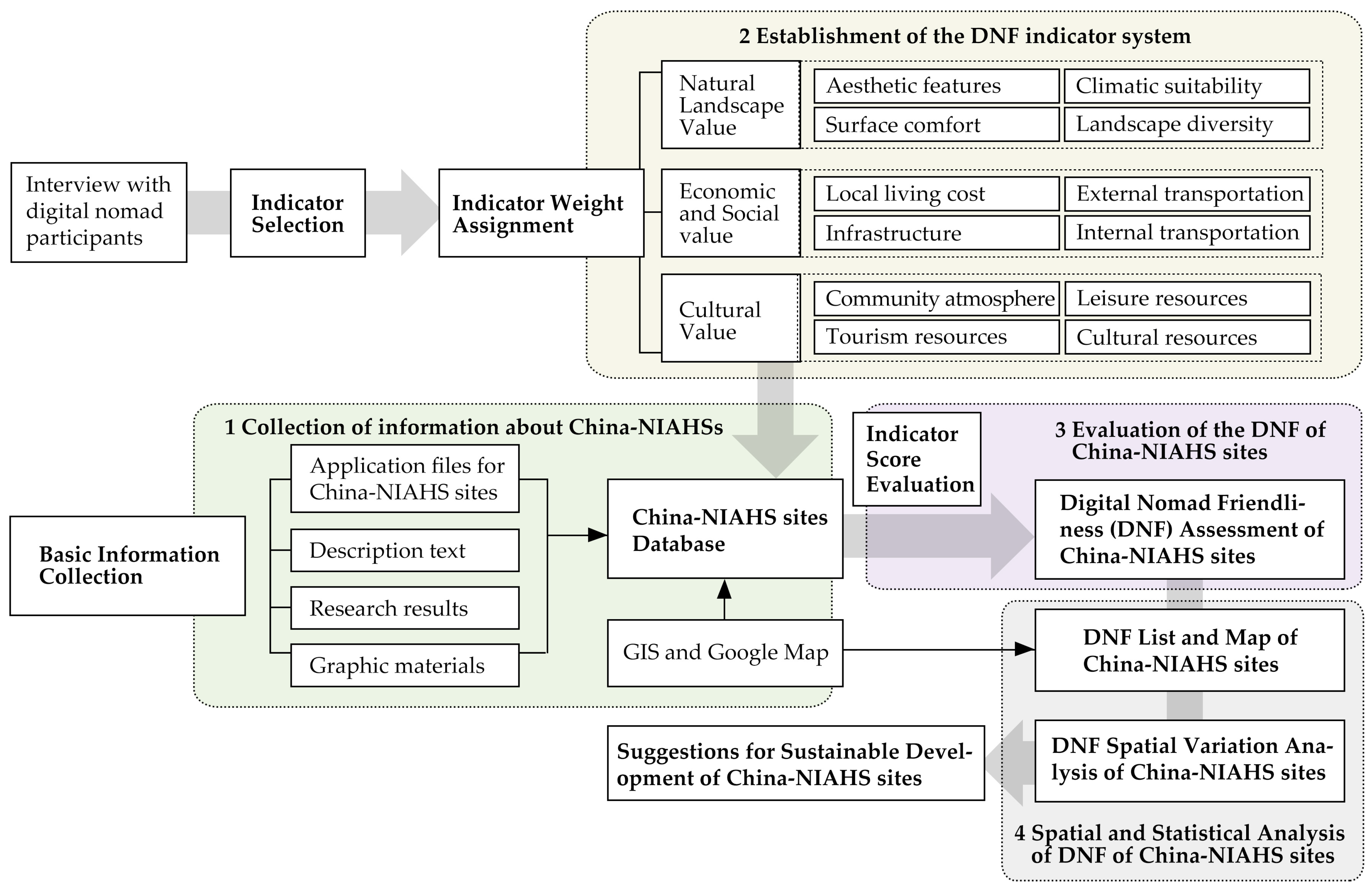
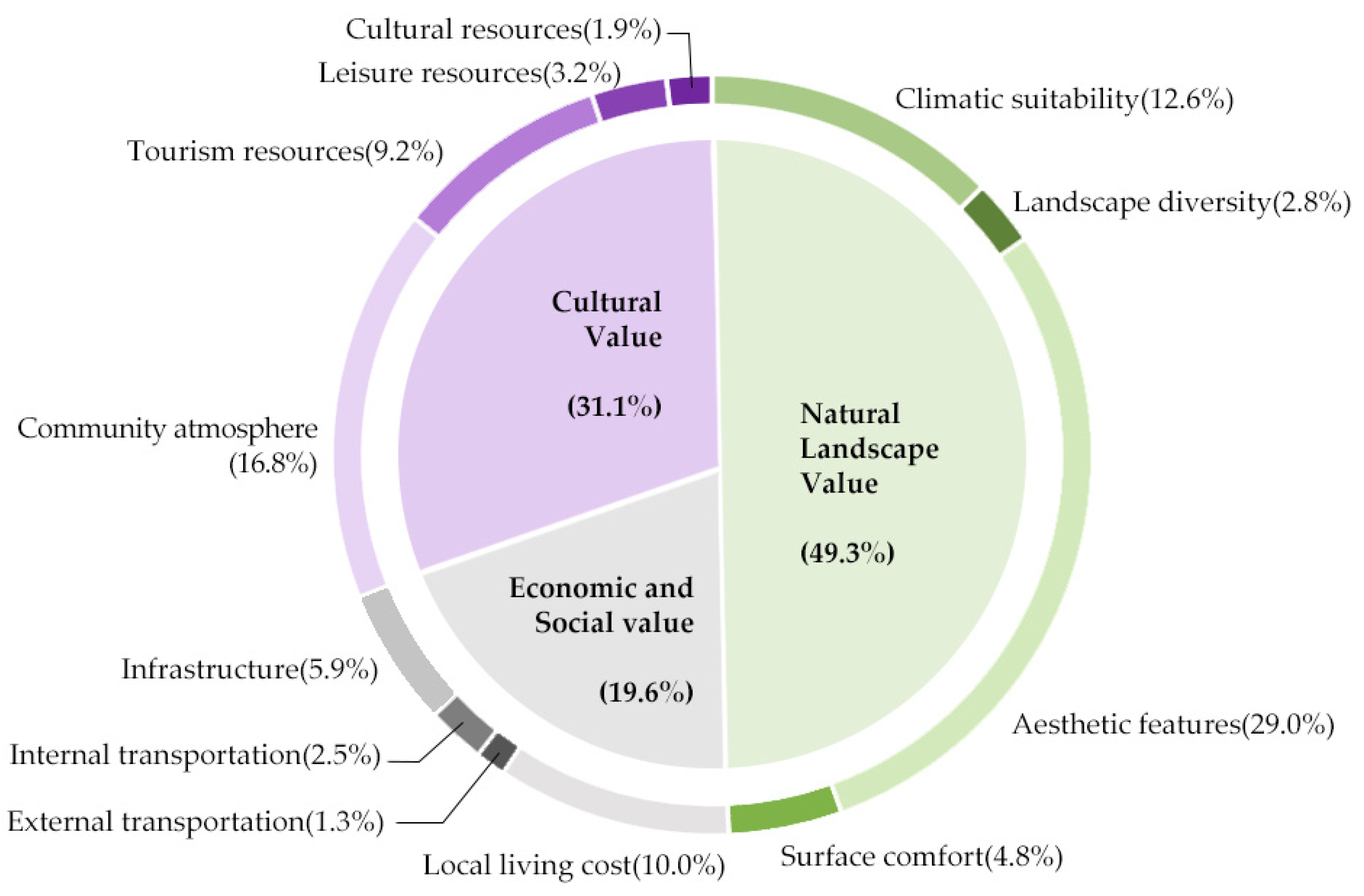
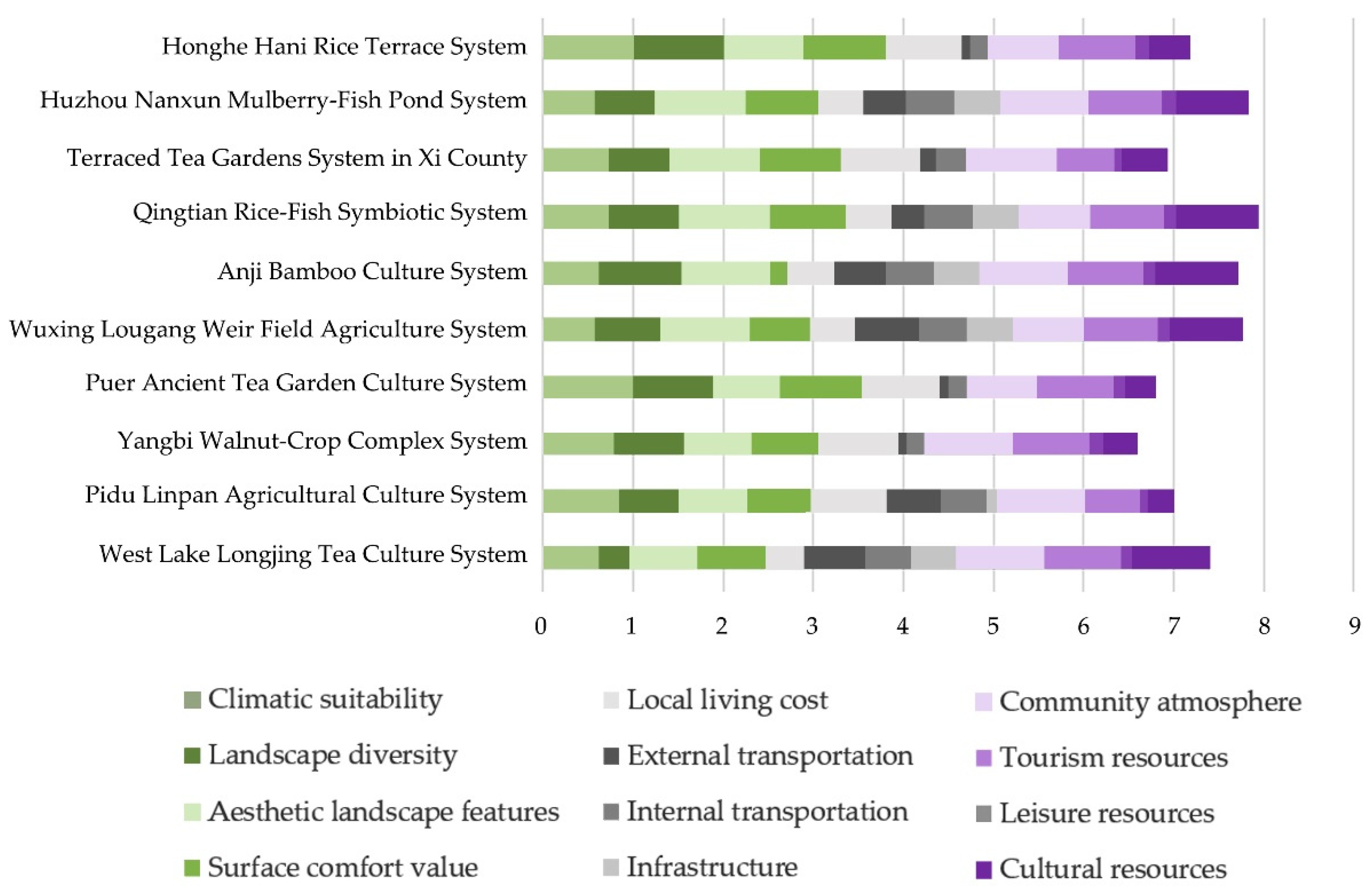

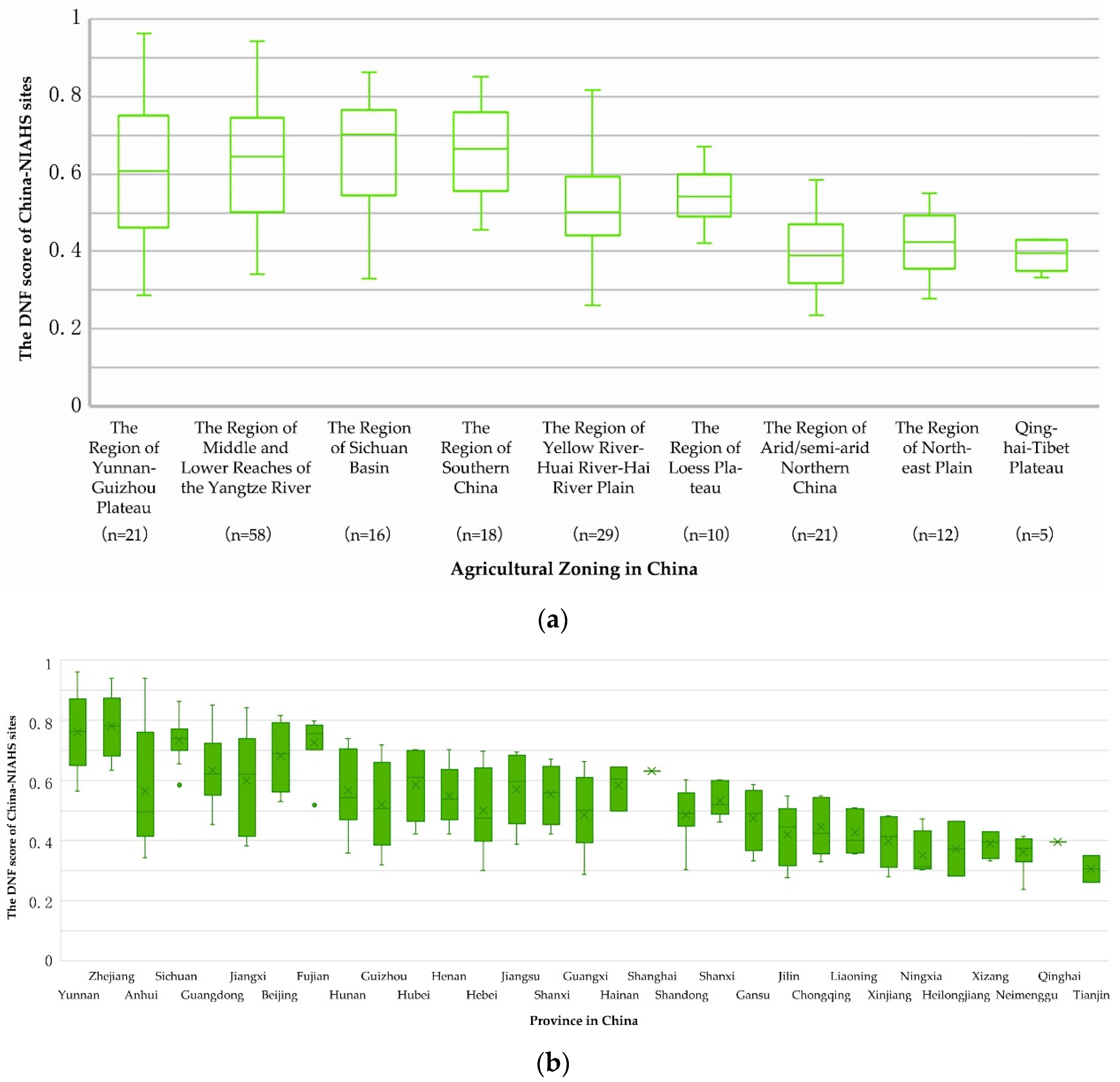
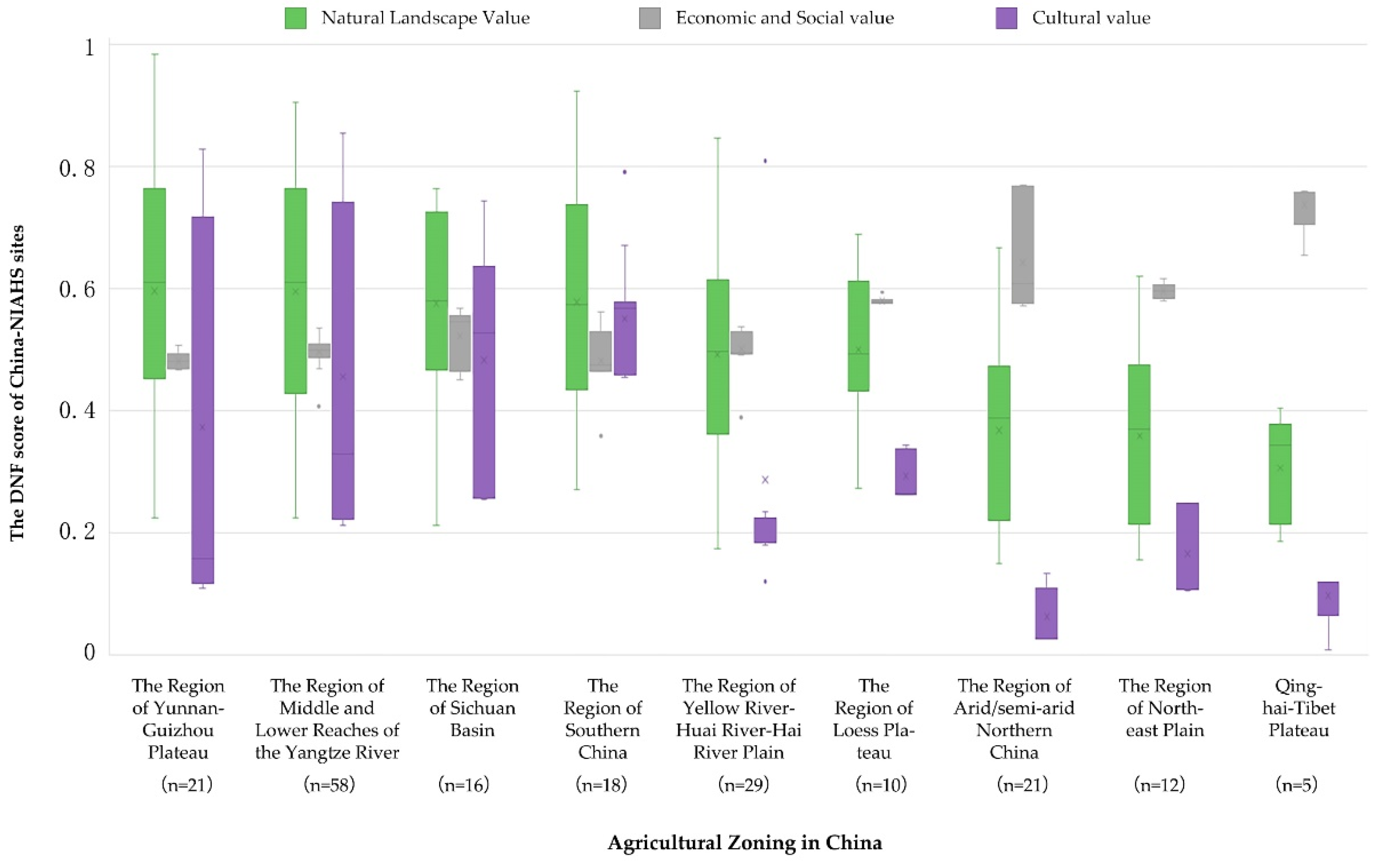
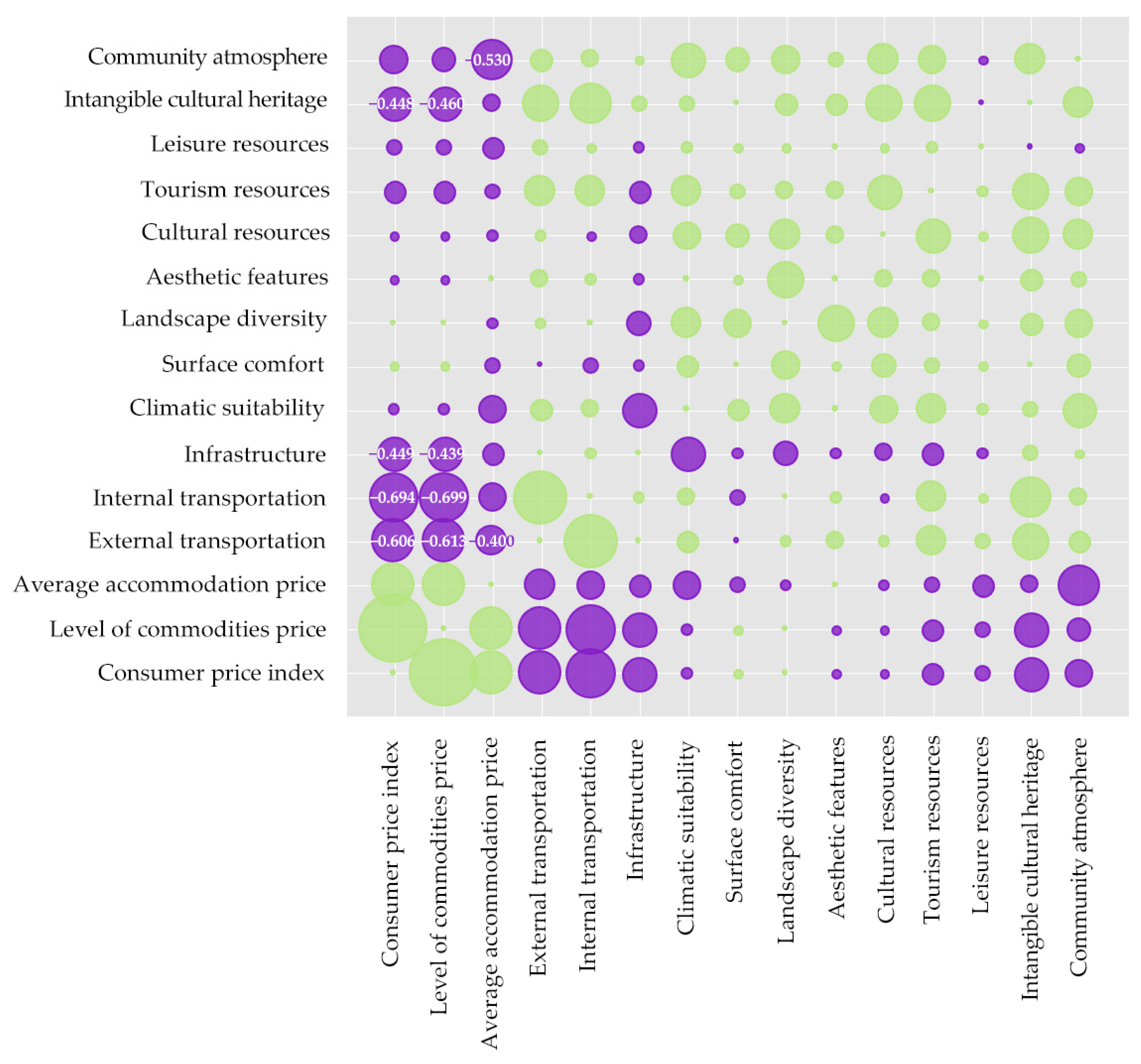
| Name of China-NIAHS | Interpretation of Indicator | Agricultural Biodiversity | Aesthetic Landscape Features |
|---|---|---|---|
| Huzhou Mulberry-dyke and Fish-pond System, Zhejiang | Ponds with mulberry trees planted on the banks, and leaves for silkworms; silkworm waste is used to feed fish; rich in silkworm culture, festivals, tourism, silk production, freshwater aquaculture. | 1 | 0.8 |
| Xinghua Duotian Agrosystem, Jiangsu | “Integrated production of forests, crops, ponds, and fish; unique landscapes and tourism. | 0.6 | 1 |
| Zhangqiu Onion cultivation system, Shandong | Traditional cultivation involves the rotation of scallions and wheat for two years or more. | 0.4 | 0.2 |
| Goal Level | Weight | Factor | Weight | Indicator | Weight | |
|---|---|---|---|---|---|---|
| Digital Nomad Friendly (DNF) assessment | Natural Landscape Value | 0.493 | Climatic suitability | 0.255 | Annual average of climatic suitability | 0.500 |
| Duration/months of comfortable weather period | 0.500 | |||||
| Landscape diversity | 0.057 | Agricultural biodiversity | 0.333 | |||
| Biodiversity intactness | 0.333 | |||||
| Biological Abundance Index | 0.333 | |||||
| Aesthetic landscape features | 0.590 | Uniqueness, scenery, visuality of agricultural heritage landscape | 1.000 | |||
| Surface comfort value | 0.098 | Tree cover and forest landscape intactness | 0.500 | |||
| Water coverage | 0.500 | |||||
| Economic and Social value | 0.196 | Local living cost | 0.509 | Consumer price index | 0.333 | |
| Level of commodities price | 0.333 | |||||
| Average accommodation price | 0.333 | |||||
| External transportation | 0.065 | Passenger volume | 0.333 | |||
| Number of flights | 0.333 | |||||
| Number of trains | 0.333 | |||||
| Internal transportation | 0.127 | Number of taxis | 0.333 | |||
| Public transportation services | 0.333 | |||||
| Availability of subway/metro | 0.333 | |||||
| Infrastructure | 0.299 | Public services | 0.500 | |||
| Degree of digital rural development | 0.500 | |||||
| Cultural Value | 0.311 | Community atmosphere | 0.540 | Existing digital nomad community | 0.500 | |
| Number of Public libraries for every 10,000 people | 0.500 | |||||
| Tourism resources | 0.295 | Abundance of tourism resources | 1.000 | |||
| Leisure resources | 0.103 | Abundance of leisure resources | 1.000 | |||
| Cultural resources | 0.062 | Cultural village | 0.500 | |||
| Non-material cultural heritage | 0.500 |
| Ranking | Name | Province | Location | Agricultural Zones | DNF |
|---|---|---|---|---|---|
| 1 | Hani Rice Terrace System, Honghe, Yunnan | Yunnan | Honghe | Yunnan-Guizhou Plateau Region | 0.801951 |
| 2 | Nanxun Mulberry-Fish Pond System, Huzhou, Zhejiang | Zhejiang | Nanxun | Middle and Lower Reaches of Yangtze River Region | 0.78434 |
| 3 | Terraced Tea Gardens System, Xi County, Anhui | Anhui | Xi County | Middle and Lower Reaches of Yangtze River Region | 0.783723 |
| 4 | Qingtian Rice-Fish Symbiotic System, Zhejiang | Zhejiang | Qingtian | Middle and Lower Reaches of Yangtze River Region | 0.776847 |
| 5 | Anji Bamboo Culture System, Zhejiang | Zhejiang | Anji | Middle and Lower Reaches of Yangtze River Region | 0.77165 |
| 6 | Wuxing Lougang Weir Field Agriculture System, Zhejiang | Zhejiang | Wuxing | Middle and Lower Reaches of Yangtze River Region | 0.747948 |
| 7 | Puer Ancient Tea Gardens and Tea Culture System, Yunnan | Yunnan | Puer | Yunnan-Guizhou Plateau Region | 0.726981 |
| 8 | Yangbi Walnut-Crop Complex System, Yunnan | Yunnan | Yangbi | Yunnan-Guizhou Plateau Region | 0.725055 |
| 9 | Pidu Linpan Agricultural Culture System, Sichuan | Sichuan | Pidu | Sichuan Basin Region | 0.719053 |
| 10 | West Lake Longjing Tea Culture System, Zhejiang | Zhejiang | West Lake | Middle and Lower Reaches of Yangtze River Region | 0.708759 |
Disclaimer/Publisher’s Note: The statements, opinions and data contained in all publications are solely those of the individual author(s) and contributor(s) and not of MDPI and/or the editor(s). MDPI and/or the editor(s) disclaim responsibility for any injury to people or property resulting from any ideas, methods, instructions or products referred to in the content. |
© 2024 by the authors. Licensee MDPI, Basel, Switzerland. This article is an open access article distributed under the terms and conditions of the Creative Commons Attribution (CC BY) license (https://creativecommons.org/licenses/by/4.0/).
Share and Cite
Zhang, M.; Yu, Y.; Liu, M.; Liu, J. Opportunities for China’s Agricultural Heritage Systems under the “Digital Nomadism” Trend—A Stakeholder-Weighted Approach. Sustainability 2024, 16, 2918. https://doi.org/10.3390/su16072918
Zhang M, Yu Y, Liu M, Liu J. Opportunities for China’s Agricultural Heritage Systems under the “Digital Nomadism” Trend—A Stakeholder-Weighted Approach. Sustainability. 2024; 16(7):2918. https://doi.org/10.3390/su16072918
Chicago/Turabian StyleZhang, Menghan, Yue Yu, Meizi Liu, and Jingyi Liu. 2024. "Opportunities for China’s Agricultural Heritage Systems under the “Digital Nomadism” Trend—A Stakeholder-Weighted Approach" Sustainability 16, no. 7: 2918. https://doi.org/10.3390/su16072918
APA StyleZhang, M., Yu, Y., Liu, M., & Liu, J. (2024). Opportunities for China’s Agricultural Heritage Systems under the “Digital Nomadism” Trend—A Stakeholder-Weighted Approach. Sustainability, 16(7), 2918. https://doi.org/10.3390/su16072918






